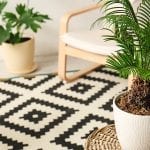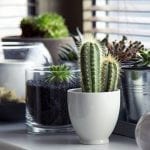
Quick Tips & Tricks to Style Your Indoor Plants
Are your houseplants ho-hum? Could they use a makeover? A new pot or the right accessory can take your favorite indoor plants from pretty good to gorgeous.
Here we’ll cover plant styling tips, including location, display, and color.
Places and Spaces – Where to Display Your Indoor Plants
Living Room
A large, eye-catching plant on the living room floor or atop a console adds texture and a touch of ‘green’ to a social space. The color green works as a neutral and coordinates with any interior décor.
Grow a fiddle leaf fig or an oversized cactus next to the couch to make a designer statement. Both plants are easy to grow and care for.
Entryway
Add a bright touch to your entrance with colorful greenery. Indoor flowering plants add a vibrant ‘natural’ feel and are an excellent way to greet guests. A fan palm works well in a front doorway with a lot of light.
For shady entrances with less light, consider the Swiss-cheese plant. A single, bold branch in a vase makes for a designer-approved entry space.
Bathroom
Baths tend to be short on décor due to constant humidity, but humid, low-light conditions are perfect for growing a variety of greenery. Devil’s Ivy works well as a bath plant, requiring minimal light and water weekly.
A Boston Fern or a Staghorn Fern will add textural interest and brighten up a dull bath.
Other Spaces
Consider adding one plant stand if you have a lonely corner in a guest bedroom or office. Plant stands are designed to fit into small, undecorated corners throughout a room. And are sold in a wide variety of styles, colors, and materials so that you can create a statement no matter your style.
On the Tabletop
Small succulents or air plants grouped inside a glass terrarium make a stunning focal point for a coffee or side table. Grow an easy Chinese Money Air Plant beside a reading chair highlights a quiet space.
Match the Pot to the Plant
When choosing a plant container, pick a color and shape that will work well with the form and texture of the plant. A tall Mother’s In-laws Tongue matches well with a modern, sleek container. A frilly Asparagus Fern pairs well with a curvy, more organic design.
As a rule, plants that grow in a straight or angular fashion look best in a modern pot, while flowery, frilly types pair well with natural, organic containers. Pick a container that will complement the plant and the room it will be placed in.
Although a standard terracotta pot works well for most indoor flowering plants regardless of texture, it’s not very interesting. Consider flea market finds such as old trunks, woven baskets, or large coffee cans as unique containers for a vintage look.
Take Your Color Cues From a Floral Expert
Choosing bloom or foliage colors that contrast or complement one another is a florist’s specialty. You can use this same easy technique when styling your home.
A pot of blooming lavender will emit a calm, cool feel when planted in a blue or mauve container (complementary colors). The same lavender in a bright yellow pot (contrasting color) adds excitement to a space.
The mustardy yellow bloom of Kalanchoe placed in a light green container is soothing to the eye (complementary color). At the same time, the same sunny flowers in a bright purple pot make an eye-catching arrangement (contrast). When in doubt, consult a color wheel.
White petunias in a black pot make a refined black-and-white décor (contrast). The same snow-white blooms in a sky-blue container provide a cool, refreshing feel.
If you have extra terracotta pots and saucers in the shed, spray paint them in color to complement the room’s décor.
Make an Impact by Grouping Indoor Plants
When grouping indoor flowering plants, consider a daily technique by interior designers. Group your pots in odd numbers – three, five, or seven.
For the best visual impact, group materials and colors complement one another. To group greenery on a mantel, combine plants of various heights and textures to make the most significant impact.
Combine frilly, leafy, and tall plants for maximum impact.
Hanging Plants for Impact – How Do I Hang an Indoor Plant?
Consider hanging an indoor plant for empty spots near a window or in an unused corner. A bit of leafy greenery tucked in a macramé plant hanger and hung in a sunny window emits a natural, relaxed vibe.
Hanging plants are a great way to decorate a small living space.
Hanging an Indoor Plant
What You’ll Need:
- Bathroom scale
- Ceiling hook kit with included toggle bolt and support hardware
- Hand Drill
- Stepladder
Keep in mind a hanging pot with soil can be quite heavy. You will need a sturdy plant hook securely attached to the ceiling. The plant hanging kit should include a toggle bolt and hardware to secure the hook to the ceiling. It’s easy to check the weight rating indicated on the packaging.
- Set the container in the holder on a bathroom scale to check the weight. Or weigh another similarly sized plant to the one you intend to display.
- Drill a pilot hole in the ceiling, making the hole slightly smaller than the width of the toggle bolt or the section that fits into the ceiling.
- Insert the end of the bolt or hook into the ceiling. Turn it clockwise to tighten securely; for winged bolts, squeeze the ‘wings’ closed as you push the bolt up through the hole. Twist the bolt clockwise to tighten.
Expert Tips:
If you wish to rotate your hanging plant, so it receives even sunlight, ceiling hook kits are also sold in swiveling versions.
A standard threaded hood may suffice to hang a lightweight plant from a wooden beam or ceiling joist. Threaded hooks can be screwed directly into the wood – no toggle bolt is required.
Did you know? Indoor Plants have proven health benefits. They lift your mood and decrease cortisol levels –the stress hormone. Also, indoor plants release oxygen into the air and filter out indoor pollutants. What’s not to love?
Images by Marco Verch and Nico Paix.













